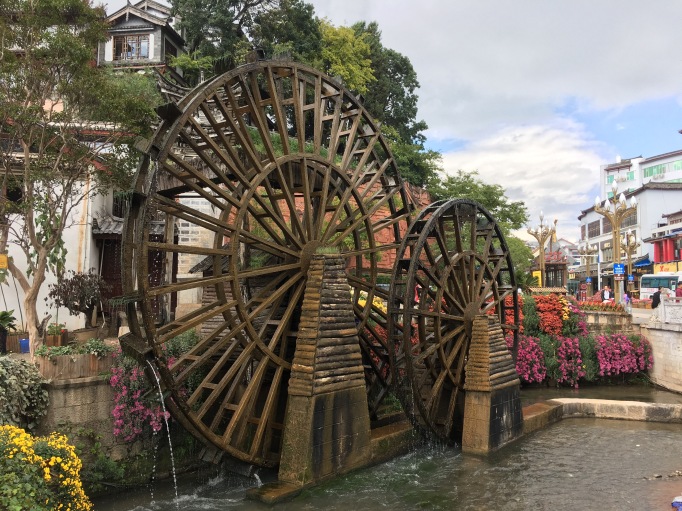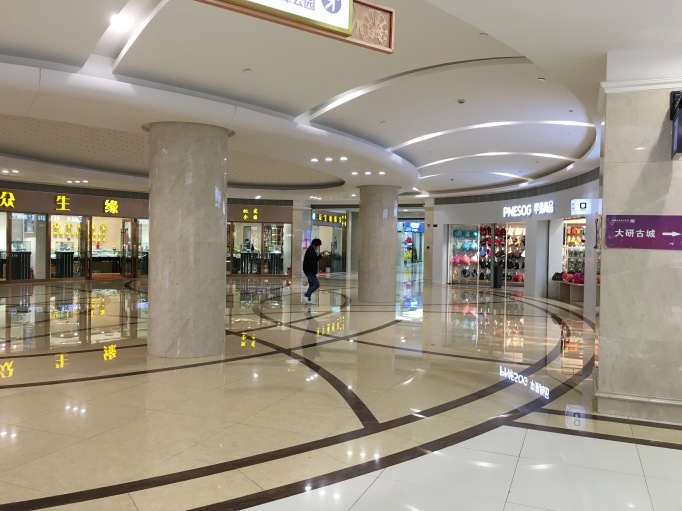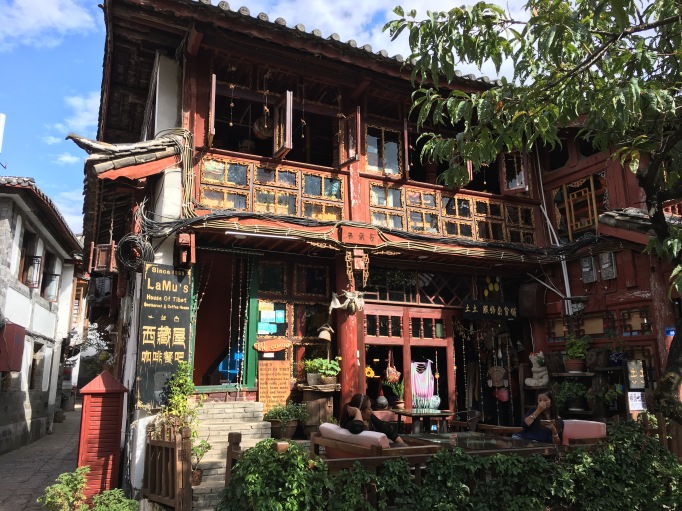The early alarm call hastened Mr L from his bed and off on his trekking adventure. Meanwhile, I was off to explore the Old Town of Lijiang…….
The Old Town of Lijiang, located in the Lijiang Autonomous County of the Naxi Ethnic Minority, lies in the northwest of Yunnan Province at an altitude of 2,418m. It is listed as one of the four best preserved ancient cities in China; the others are Langzhong Ancient City in Sichuang, Pingyao Ancient City in Shanxi, and Shexian Ancient City. Lijiang and two villages to the north, Baisha and Shuhe, were listed as UNESCO World Heritage sites in 1997. Since then, the local government has taken more responsibility for the development and protection of the old city and Lijiang’s tourism has increased over the past twenty years. Travellers from around the world visit but most tourists are still Han Chinese (majority ethnic group) from other parts of China.
The Old Town occupies an area of 3.8 square kilometers (912 acres), was originally built in the late Song Dynasty and the early Yuan Dynasty, and has a history of more than 800 years. It is built along the lie of mountains and the flow of rivers and is the only old city built without a city wall. The story goes that Lijiang had been under the reign of the hereditary Mu family for more than 500 years. If the Chinese character ‘Mu’, representing the governor of Lijiang, is put into a frame representing a city wall, you have the character ‘Kun’ which means ‘siege’ or ‘predicament’. This would mean that the governing Mu family and their descendants would always be trapped. Because of this symbolism, Old Town Lijiang was never given a city wall.
The centre of the Old Town is Square Street (Sifangjie) and 4 main streets radiate from this point extending in 4 different directions. Countless lanes which extend in all directions form a network and connect every corner of the town. Streets in the Old Town are paved by the local bluestones which are neither muddy in the rainy season nor dusty in the dry season, and add a sense of antiquity to the Old Town. The sluice at the centre of town is opened late in the night and the resulting current of water flushes and washes all the streets to keep the town clean. This practical use of water is part of the daily life of the residents in Old Town. Again the town is spotless at all times with no rubbish seen on the ground irrespective of how big the crowds are.
All water flows into streams from the 2 big water wheels in the Jade River Square so as long as you find one of the many streams and follow the water upstream you always end up back at the water wheels meaning it is impossible to get lost (thanks to Mr L for imparting this gem).

After an excellent breakfast of Yunnan coffee and toast at the wonderful N’s Kitchen, I spent many a happy hour meandering the streets and working out how the multitude of lanes intersect and meet up.
I watched locals dancing in Square Street, and later on dancing in the Jade River Square park near the water wheels. A tuk-tuk with a huge speaker played the music whilst locals, some in traditional costume, danced a sort of line dance. Later in the afternoon when I returned they were still dancing with numbers significantly increased, and by the evening the dancing was all finished.
The afternoon was interspersed with a rest and sustenance at the delightful Prague Cafe. My wanderings took me out to the perimeter of the Old Town where I was looking for an indication of where to catch a bus for tomorrow’s adventure. There were some escalators going down so I gave them a go and cane upon a huge brightly lit shopping centre that sits underneath the Old Town – not what I expected to find at all!

My evening meal was at LaMu’s House of Tibet restaurant and an excellent meal it was too – vegetable curry momos, Tibetan sliced potatoes in tomato and garlic with a glass of Yunnan red wine (a bit sweet for my liking, but pleasant enough).

I then had a ticket to go to the Naxi Ancient Music concert, a daily occurrence at 20.00 every evening and lasting about 75 minutes. The orchestra of 18 included 6 octogenarians and outnumbered the audience of 11! The music was very different to my western ear, played on very unusual looking instruments. Some was very pleasant and melodic whilst other pieces sounded harsh and discordant. As for the singing – not to my liking as high pitched and screechy! A good experience nevertheless to experience a small part of Naxi culture.
The people of the Naxi ethnic minority mostly live in Lijiang and form the majority of the population here, while the rest live in Sichuan and Tibet. The Naxi are famous for their Ancient Music, the traditional Naxi classical music that is regarded as a ‘living fossil of Chinese music.’
All in all a good day although a bit strange not having Mr L to share the experience with.
Distance walked: 20,338 steps / 8.79 miles










